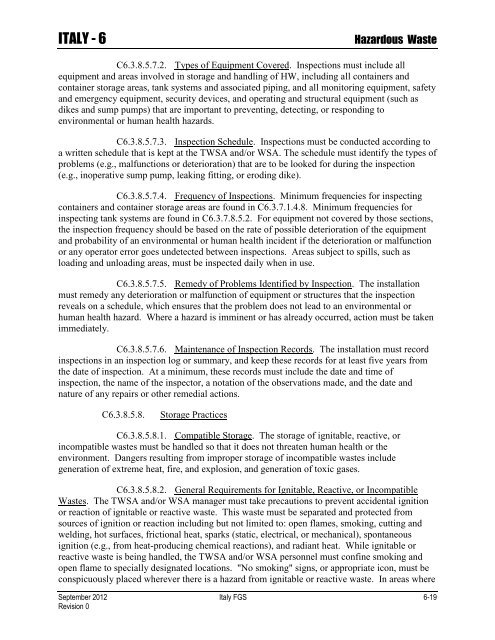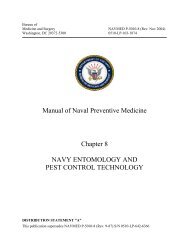ENVIRONMENTAL FINAL GOVERNING STANDARDS ITALY
ENVIRONMENTAL FINAL GOVERNING STANDARDS ITALY
ENVIRONMENTAL FINAL GOVERNING STANDARDS ITALY
You also want an ePaper? Increase the reach of your titles
YUMPU automatically turns print PDFs into web optimized ePapers that Google loves.
<strong>ITALY</strong> - 6 Hazardous Waste<br />
C6.3.8.5.7.2. Types of Equipment Covered. Inspections must include all<br />
equipment and areas involved in storage and handling of HW, including all containers and<br />
container storage areas, tank systems and associated piping, and all monitoring equipment, safety<br />
and emergency equipment, security devices, and operating and structural equipment (such as<br />
dikes and sump pumps) that are important to preventing, detecting, or responding to<br />
environmental or human health hazards.<br />
C6.3.8.5.7.3. Inspection Schedule. Inspections must be conducted according to<br />
a written schedule that is kept at the TWSA and/or WSA. The schedule must identify the types of<br />
problems (e.g., malfunctions or deterioration) that are to be looked for during the inspection<br />
(e.g., inoperative sump pump, leaking fitting, or eroding dike).<br />
C6.3.8.5.7.4. Frequency of Inspections. Minimum frequencies for inspecting<br />
containers and container storage areas are found in C6.3.7.1.4.8. Minimum frequencies for<br />
inspecting tank systems are found in C6.3.7.8.5.2. For equipment not covered by those sections,<br />
the inspection frequency should be based on the rate of possible deterioration of the equipment<br />
and probability of an environmental or human health incident if the deterioration or malfunction<br />
or any operator error goes undetected between inspections. Areas subject to spills, such as<br />
loading and unloading areas, must be inspected daily when in use.<br />
C6.3.8.5.7.5. Remedy of Problems Identified by Inspection. The installation<br />
must remedy any deterioration or malfunction of equipment or structures that the inspection<br />
reveals on a schedule, which ensures that the problem does not lead to an environmental or<br />
human health hazard. Where a hazard is imminent or has already occurred, action must be taken<br />
immediately.<br />
C6.3.8.5.7.6. Maintenance of Inspection Records. The installation must record<br />
inspections in an inspection log or summary, and keep these records for at least five years from<br />
the date of inspection. At a minimum, these records must include the date and time of<br />
inspection, the name of the inspector, a notation of the observations made, and the date and<br />
nature of any repairs or other remedial actions.<br />
C6.3.8.5.8. Storage Practices<br />
C6.3.8.5.8.1. Compatible Storage. The storage of ignitable, reactive, or<br />
incompatible wastes must be handled so that it does not threaten human health or the<br />
environment. Dangers resulting from improper storage of incompatible wastes include<br />
generation of extreme heat, fire, and explosion, and generation of toxic gases.<br />
C6.3.8.5.8.2. General Requirements for Ignitable, Reactive, or Incompatible<br />
Wastes. The TWSA and/or WSA manager must take precautions to prevent accidental ignition<br />
or reaction of ignitable or reactive waste. This waste must be separated and protected from<br />
sources of ignition or reaction including but not limited to: open flames, smoking, cutting and<br />
welding, hot surfaces, frictional heat, sparks (static, electrical, or mechanical), spontaneous<br />
ignition (e.g., from heat-producing chemical reactions), and radiant heat. While ignitable or<br />
reactive waste is being handled, the TWSA and/or WSA personnel must confine smoking and<br />
open flame to specially designated locations. "No smoking" signs, or appropriate icon, must be<br />
conspicuously placed wherever there is a hazard from ignitable or reactive waste. In areas where<br />
September 2012 Italy FGS 6-19<br />
Revision 0
















